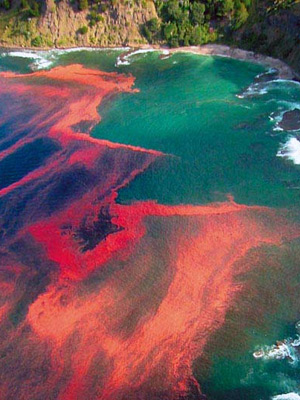


Over the last 20 years, Red Tides have grown in occurrence and size. They can and have caused waters to turn red in color and kills marine life in large numbers. The appearance is red water with dead animals on the beach...
Red tide is a common name for a phenomenon more correctly known as an algal bloom (large concentrations of microorganisms), an event in which estuarine, marine, or fresh water algae accumulate rapidly in the water column and results in discoloration of the surface water. It is usually found in coastal areas. Red Tide is also caused by dinoflagellates.
These algae, more specifically phytoplankton, are single-celled protists, plant-like organisms that can form dense, visible patches near the water's surface. Certain species of phytoplankton, such as Dinoflagelate, contain photosynthetic pigments that vary in color from green to brown to red.
When the algae are present in high concentrations, the water appears to be discolored or murky, varying in color from purple to almost pink, normally being red or green. Not all algal blooms are dense enough to cause water discoloration, and not all discolored waters associated with algal blooms are red. Additionally, red tides are not typically associated with tidal movement of water, hence the preference among scientists to use the term algal bloom.